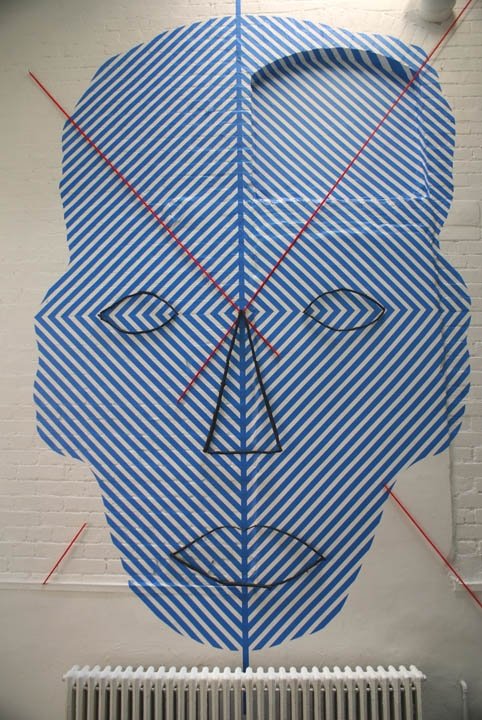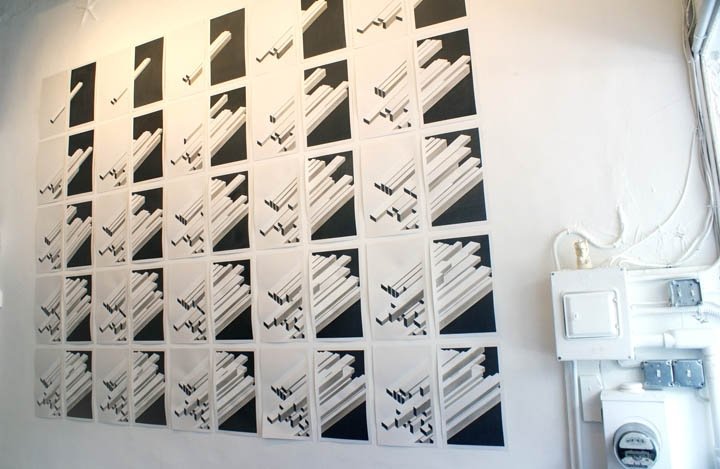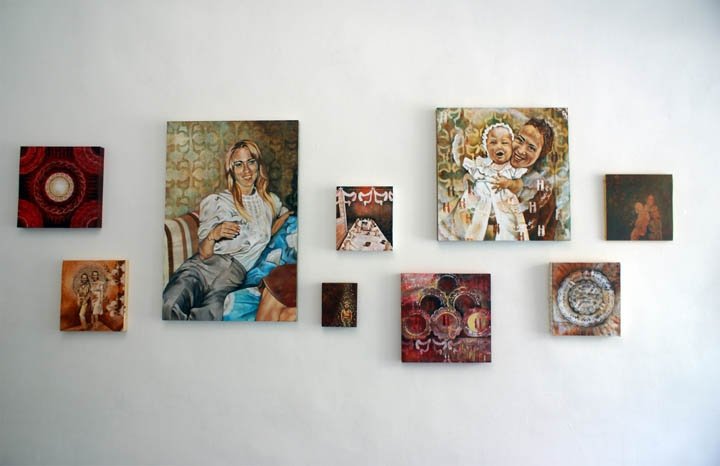Left: Jenn DePalma, Right: Reuben Breslar; installation details in Transformer, 2010.
E7: Tetrad
JUNE 25 - AUGUST 14, 2010
Reuben Breslar, Jennifer DePalma, Adam Dwight, and Treva Elwood
Guest Curated by Page Carr
ABOUT THE EXHIBITION
Featuring new works by Reuben Breslar, Jennifer DePalma, Adam Dwight, and Treva Elwood, 2010's Exercises for Emerging Artists program, guest-curated by artist and professor Page Carr, highlights various incarnations of drawing, painting, and animation that explore themes of artistic process, personal history, character study, and the struggle for perfection.
Launched in March 2004, Transformer's Exercises For Emerging Artists was created to support artists at critical points or crossroads in their professional growth and development, and to advance participating artists' creative careers. Consisting of a series of two-hour, bi-weekly gatherings spanning three months, the program is designed to stimulate and encourage participating artists as they create new work. In addition to peer critique sessions, the participating artists received mentorship and critical feedback on their work from artists Billy Colbert and Molly Springfield, as well as Andrea Pollan, Director of Curator's Office.
In selecting artists for this 7th year of the Exercises, guest curator Page Carr states,
"I looked for artists with energy, drive, and intensely individual ways of thinking and generating ideas who were also ready and eager to enter into a vigorously supportive group critique. Three of the artists had not been in art school for several years; one had not been in art school at all… As different as their approaches were, all four artists took keen and positive interest in one another's problems and ideas, multiplying energy, maintaining momentum, and deepening awareness."
A critique meeting with the E7: Tetrad artists and guest artist mentor Billy Colbert. From left to right: Billy Colbert, Adam Dwight, Reuben Breslar, Treva Elwood, and Jennifer DePalma. Special thanks to Don Russell and Provisions Library for hosting.
Reuben Breslar, Output #1: YOU, ME, US, THEM 06242010, 2010, blue painters tape, yarn, wood, and metal wire, Dimensions variable.
Reuben Breslar, drawing from binder accompanying installation, 2010, pen on paper.
Jennifer DePalma, 1 - 25, 2010, gesso, graphite, & pencil on paper, Each drawing: 12 x 19
Jennifer DePalma, 1 - 25 installation detail, 2010
The E7: Tetrad artists discuss Jennifer DePalma's work in progress during a May 2010 critique meeting at Provisions Library with guest curator Page Carr.
Adam Dwight, Still from Anti-Majesty, 2010, Animated video, 3:42, Ed. 1/3
Adam Dwight, U, 2010, pen and gouache, 18 x 24
Adam Dwight, U, 2010, pen and gouache, 18 x 24
Adam Dwight, New Growth, 2010, pen and gouache, 18 x 24
Treva Elwood, installation view, 2010
Treva Elwood, ...And She Had Her Mother's Hands..., 2010, Oil on wood panel, 24 x 36
Treva Elwood, No Plates, 2010, oil on wood panel, 10 x 11.5
Treva Elwood, Character Study (detail), 2010, Oil on wood panel, 11 ¾ x 11 ¾
Treva Elwood and Adam Dwight during an artist talk with guest curator Page Carr, July 24, 2010.
Artist talk with Treva Elwood, Adam Dwight, and guest curator Page Carr, July 24, 2010
E7: Tetrad artist talk with Treva Elwood & Adam Dwight, July 24, 2010 at Transformer.
ABOUT THE ARTISTS
Reuben Breslar's work deals with the reconciliation of the gaps and similarities between science and art.
About his work in general and his project for E7:Tetrad, Reuben states,
"Methods of research are important here and rely on equations and data organization to direct a path of thought. This model of idea generation guides my process of creating art and establishing metaphor as an overriding principle of relativity… In playing the double roles of quasi-scientist and lab rat, I get the chance to investigate myself in the greater scheme of society, as one part of a larger whole. It is a matter of self-awareness."
During his time in the Exercises program, Reuben has amassed a prolific body of paintings, drawings, and notes. Though these works are each specific and often seemingly disparate in content, Reuben has carefully edited and arranged them into a wall composition mimicking a form viewers will relate to instantly, reflecting his interest in how human beings collect, contain, and respond to information and imagery.
Jennifer DePalma's 1 – 25 is as much a record of a personal challenge as it is a work of art. Jenn set out to create a series of 25 pairs of drawings – 25 being her age when she began the series. Beginning with a rectangular prism rendered in both high and low key lighting perspectives, a new "cuboid" was added each time she started a new pair of drawings. While striving to make each drawing as perfect and accurate as possible, she encountered inevitable mistakes and the process of accepting these imperfections.
About her process, Jenn says,
"I began to see the bend of my straight edges. The curves became obvious but it was too late. The lighting cast a shadow of my ruler distorting my sightlines, but I'd already begun. The only thing to do was continue and finish…I stretched distances and relied on the eye rather than the pencil, I pushed through difficulties and accepted mistakes. I erased thousands of barely seen smudges and lines. Forward into the future, I worked setting up the still life and measuring accumulation. All this to reach a state of completion, 25 works in pairs."
The resulting grid of drawings is immediately bold, striking, and apparently mathematical in execution. Peering closer at the drawings, however, viewers will discover their subtle discrepancies and the artist's "hand" in the work, which persistent attempts at perfection failed to hide.
Adam Dwight – Greatly interested in character studies, Adam worked to develop and articulate personal histories through illustration, animation, and audio in Anti-Majesty. Both dark and humorous, Anti-Majesty attempts to break barriers between audience bias, storytelling, and metaphor, "using the vehicle of cartoons to etch the symbolism of these characters' lives into their flesh."
Adam says,
"I make humans who are unapologetic objects of bigotry, asking my audience to believe in their particular histories, relationships, and obsessions. Anti-Majesty is a simulation of the cruelty of judgment, performed in the interest of creating an instance of pure comedy."
Treva Elwood - Through Genetic Endowment, Treva considers "the human body as a complex, delicate, and finite physical system," one that predetermines who a person is and what legacies they will leave behind based on their genetic composition. The series of paintings presented in this exhibition is partly a meditation on her inherited traits and the family members from whom she has received them. Building a visual vocabulary through symbols of delicacy, physicality, and personal history, Treva draws on her own experience to communicate relatable, mortal issues all human beings share.
She states,
"I aim to convey how human beings are, quite literally, physically limited units of information determined by their predecessors' genetic coding, and whose coding will, in turn, determine their successors' lives. Simultaneously, I hope to reference and acknowledge the seemingly independent and disconnected emotional abstract qualities of human existence contained by our physical bodies."

















